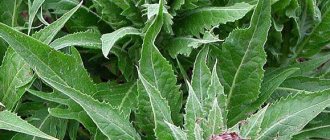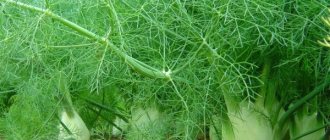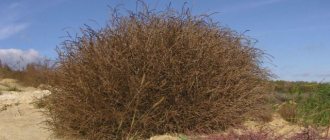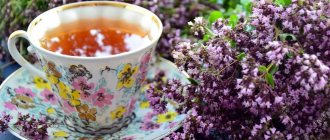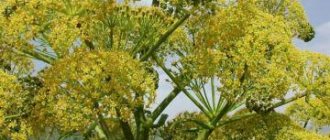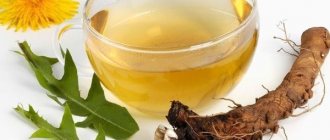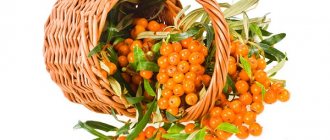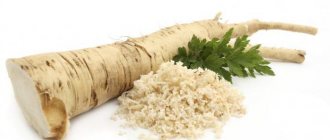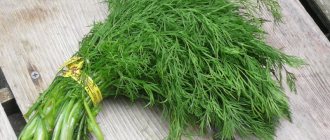General information about the plant
Redroot is a perennial plant that can be over 80 years old. The above-ground part reaches 50-60 cm in height. Only the roots are valuable for human health. Since they go quite deep, their extraction is a labor-intensive process.
Properly prepared Altai root (it got its name from its homeland) is an excellent medicine for many disorders. It cures only when collected at the appropriate time and from a mature plant.
Interestingly, animals do not shy away from this plant. Bearroot is another name derived from the bears that dig up the rhizomes for their own use.
Procurement rules
In order for the male root to produce its full effect, it is necessary to dig up the rhizomes in September-October. To prevent the plant from being damaged, re-collection of raw materials is possible only after 10 years. During this period, the roots grow back and the tree does not suffer.
Attention! Fast-growing analogues will not bring the desired effect. Forgotten kopeck (as the plant is popularly called) can also be harvested during flowering. The herb and flowers are collected and then stored in the refrigerator until used.
Preparation and storage of pennyweed
Roots and stems are used in the preparation. The root is collected in August-September. Roots aged 10-80 years are collected, one third is left in the ground. You can collect again in the same place after 10 years. The stems, and indeed the raw materials of the kopek plant, need to be harvested when the budding phase is approaching and the plant is in flower, then the highest level of mangiferin and the highest raw material mass of the plant are recorded. When collecting, cut off the leafy stems of the pennywort with knives or pruning shears.
To preserve natural and commercial thickets of this plant, it is advisable to collect it in the same place no earlier than every other year. The grass should be dried in the sun. It needs to be stirred occasionally; the grass dries out in a few days. Precipitation should not be allowed to get on the penny grass. If the stem breaks when bending, drying is considered complete. The final yield of dry kopek grass raw material is 15-20% of the mass of fresh grass; the dried grass is ground.
According to the requirements, the raw material of the pennyweed must consist of a mixture of partially ground or whole leaves, inflorescences, and small pieces of stems. Raw materials must meet the following indicators:
- mangiferin level is not less than 1%;
- weight loss during drying is no more than 13%;
- ash, in general, no more than 9%;
- stems thicker than 2 mm in diameter no more than 10%;
- impurities (parts of other non-poisonous plants) no more than 3%;
- mineral impurity no more than 1%.
Shelf life of raw materials is 2 years.
Use in everyday life
Kopeechnik is used to make various kinds of decoctions and tinctures, including those containing alcohol.
Article on the topic: Forget-me-not field - useful properties, description
Valuable composition of the plant
The healing properties for men directly depend on the valuable substances that make up the plant. Tea pennywort is rich in the following compounds:
- coumarins;
- flavonoids;
- tannins;
- free amino acids;
- catechins;
- saponins;
- xanthone.
Some of the above compounds support the body's vascular system, improving blood circulation, which is very important for the male body. If you take this remedy regularly, you can fully provide the body with all the necessary substances, vitamins and minerals.
Action of the plant
Use for men can have a powerful effect. The protein root has the following properties:
- tonic;
- antioxidant;
- stimulating.
Men who regularly use this plant in their diet have noticed that they feel better, they have become more resilient and strong. Reviews from men show that the product normalizes the activity of the genitourinary system and gastrointestinal tract.
Red root tincture for men has another effect. It affects the central nervous system, helping a man cope with the stress of every day. He becomes more morally stable, less irritable and more optimistic.
The product helps fight colds and respiratory system problems. Due to hazardous working conditions, some suffer from chronic bronchitis every day. If you brew the red root, recovery occurs much faster.
Medicinal properties of red root for women and men
The root has a great positive effect for women; its medicinal properties are associated with the following effects:
- Actively replenishes the body's water-salt balance.
- Fights genitourinary tract infections.
- Normalizes respiratory activity.
- Doctors often recommend red root to women, whose medicinal properties include anti-carcinogenic effects.
- Has a diuretic effect.
- Facilitates liquid separation.
- Prevents the occurrence of mastopathy.
- Counteracts the occurrence of inflammatory processes.
- Relieves swelling.
- Root tincture stabilizes the condition after illnesses.
- Strengthens the vascular wall.
- Improves muscle tone and skin tone.
- Eliminates pathologies of the urinary system.
- It is a means of preventing tuberculosis.
Red roots have an equally pronounced effect on the male body. Representatives of the stronger sex are recommended to regularly use medicine from this plant. It has a calming effect, strengthens the immune system, and improves the functioning of the digestive system. It is used when performing work associated with severe nervous tension, during periods of increased stress or depression.
The protein root increases potency, improves urine flow, and stabilizes the functioning of the prostate gland. It is often recommended to take it for adenoma and gastrointestinal pathologies.
The plant is useful for people engaged in heavy physical labor. It activates metabolism in muscles, starts regeneration processes in tissues, increases body tone, relieves fatigue, increases endurance, eliminates pain and spasms in muscles.
the root of the plant is a powerful aphrodisiac that enhances sexual performance
Kopechnik activates blood circulation in the large and small circles, improving the drainage of fluid from tissues.
The plant prevents the development of varicose veins or the threat of heart attack.
Impact on male power
It is important for every man to always remain young, not depend on age and be full of strength. The photo shows a red root that will help solve all problems of this kind!
Interestingly, the red root is so named for the reddish liquid that is released when the rhizome is cut. The plant has the following effects on the male reproductive system:
- relieves pain in inflammatory diseases;
- dilates blood vessels;
- stimulates blood circulation in the pelvic organs;
- improves male libido;
- relieves spasms.
Important! The use of red root is very delicate. Due to the completely natural origin of the medicine, it is impossible to harm health, but only to carefully support it.
The use of pennyweed in folk medicine
For better results, you should also use other cleansing herbs along with pennywort. To increase the phyto-therapeutic effect, simultaneously with the red root (which contains vitamin P), vitamins C and E should be consumed, which promote increased absorption of vitamin P.
General strengthening infusion
You should brew the red root in a thermos; a root 10-15 cm long is enough for 1 liter. Pour boiling water over it, let it sit overnight, and in the morning you can already drink this healthy drink. The root can be refilled and infused 2-3 times.
Aqueous-alcoholic tincture (extract) from kopeck
You can prepare it like this: fill a 500 g jar 1/3 of the volume with dry grass or (1/2 fresh) and fill it to the brim with vodka. We put it in a cool and dark place for 10 days, then you will need to strain. Take 1 teaspoon in 100 ml of water 30 minutes before meals, 3 to 4 times a day, for about 1 month. It is better to take propolis (oil or alcohol extract) for 10 days before starting, then for 1 month tincture (herbs) of kopeck, then from a month to two any immunomodulators (herbal): calendula, nettle, meadowsweet, burdock, clover, licorice, chamomile, St. John's wort and etc. Then repeat the course: propolis, kopeck (herb), immunomodulators (including kopek roots). If necessary, conduct two to four courses per year.
Water infusion of roots (tea)
Take 25 g of roots and wash them, pour 1 liter. boiling water, then pour it into a thermos and wait about an hour. We drink it like tea, you can add honey or milk. Can be reused for filling 4-6 times. Increases immunity, very useful for sinusitis, flu, and colds.
Infusion for micro-enemas: diseases of the genitourinary system, adenoma, fibroids, fibroids, impotence, acute prostatitis
1 teaspoon of ground roots, pour into a thermos, pour 1 glass of boiling water, let sit overnight, then strain. What you get needs to be divided into 2 equal parts; micro-enemas can be done in the morning and evening. The course is 10-12 days.
For eczema and other skin diseases
You can treat with water infusion, take 1 tbsp. spoon of herb in 2 cups of boiling water, let it brew for 1 hour, strain.
For prostatitis and prostate adenoma
Pour 50 g of ground or crushed root into 0.5 liters of 40% alcohol. Leave for 3 weeks in a cool and dark place, stirring occasionally. Take 1 teaspoon 2 times a day, morning and afternoon.
Indications for use
Now there are many drugs made on the basis of pennyweed. For example, "Evalar" or "Red Root". The instructions for use contain complete recommendations on how much medication should be taken and in what quantities. Since this medicine, although natural, if you neglect simple recommendations, you can cause harm.
With the help of preparations based on the red root, be it dietary supplements or just a vodka tincture, you can successfully treat the following conditions:
- prostatitis;
- impotence;
- benign tumor;
- infertility.
Many men's problems can be solved with the help of a simple but effective natural remedy.
Red root infusion
This infusion is sometimes called a decoction.
It is prepared like this:
- Up to 30 g of powder is poured into 1 liter of hot water and infused for 1 hour in a thermos.
- Then strain and drink 1 glass 2 times a day for one month. The interval between courses of admission should be 2 months.
The tincture is sometimes drunk instead of tea. You can add honey or milk to the decoction itself if desired.
One of the preparation options: 10 g of powder is placed in a pan and 200 ml of room, pre-boiled water is added. Bring to a boil and heat in a water bath for 30 minutes. Then filter and add boiling water to 200 ml. This decoction is taken 2 tablespoons 3 times a day before meals for one month. The interval between courses of treatment is at least 2 months.
The infusion stabilizes sexual functions, normalizes the functioning of the respiratory system, cleanses the blood and improves water-salt balance.
Microclysters from red root infusion
Microclysters from this dietary supplement are made in the treatment of acute prostatitis, impotence and adenoma in men, fibroids in women. The tincture for these purposes is prepared as follows: one teaspoon of the powder mass is poured on top with hot water and left to brew in a thermos for 12 hours. The resulting product is filtered.
Microclysters are done 2 times a day - at the beginning and at the end of the day. One enema is filled with half a glass, heated to 37 degrees and, using a medical bulb, applied as directed. First, the pear itself is boiled. This method is used for 12 days.
For whom the root is contraindicated
Although the root is rich in valuable substances and very useful, it has contraindications:
- children under 12 years of age;
- insomnia;
- nervous excitability;
- exacerbation of chronic diseases;
- allergic reactions.
Some medicinal complexes may contain additional compounds, so it is important to carefully read the instructions before starting to use the medicine. If your doctor has recommended pills, it is important to look at what conditions they are suitable for and when they are prohibited. This is true even for those cases when the main active ingredient is red root.
Nuances of purchase, features of collecting and preparing plants
In pharmacies, kopeck is more often found in the form of tinctures and tablets, but only the unprocessed dried root has unchanged properties. It is sold in pharmaceutical chains, sometimes in markets.
In crushed form, it is sold as teas that can be brewed immediately. Pennywort leaves are also used to prepare decoctions, but less frequently.
Root score:
- appearance. Shape - sinuous, coiled, branching, color - light brown, surface - soft;
taste. Slightly astringent, with notes of sweetness and a pleasant aroma;
humidity level. Only a well-dried root is considered a quality product: the presence of moisture increases the risk of rot and mold.
Kopechnik is widespread in parts of Russia remote from the capital - selectively in Western Siberia and almost everywhere - in Altai and the Far East.
The best time to collect is from August to September during the budding phase.
No grinding of the product is required: the thin roots dry quickly in fresh air - in just a few days. Dried raw materials can be stored for up to two years.
Kopechnik is part of many dietary supplements with a targeted stimulating effect.
About the beneficial properties of forgotten kopek (red root):
Home Recipes
If you managed to get real and correctly collected penny root, you can independently prepare different formulations for treatment at home.
Making tea
You can brew tea using red root. Some places sell ready-made drinks with this ingredient, and sometimes you can make your own.
For a cup of ready-made tea you will need a spoon of root. It is crushed and poured with boiling water for 20 minutes. You shouldn't drink everything at once. The glass should be roughly divided into 3-4 times and drunk throughout the day.
To achieve a powerful effect, you should drink such teas in a course. Usually 10 days are enough to see positive results from treatment with a medicinal plant.
Preparing the tincture
For the tincture you will need about 50 grams of pure raw materials and half a liter of vodka. Rhizomes must be well dried and cleaned. They should be thoroughly crushed. Some people do this with a knife, while others use a blender.
The prepared raw materials should be filled with vodka. The tincture is prepared for at least a week. Then the product is filtered. The composition is taken three times a day, half a teaspoon. The tincture is dissolved in warm water and drunk on an empty stomach.
To achieve maximum results, it is important to take the formulation for at least three months. If this is not enough, the course of treatment can be repeated. However, it is important to take a break. There should be a month of rest between courses of treatment. Then the treatment is carried out again.
Using natural formulations prepared at home is always better than drugs purchased at the pharmacy. Any pill will contain chemicals and the effectiveness of the drug will be lower.
It is important to take good care of your health and not to undergo all the treatments that relatives or friends recommend. If in doubt, it is better to consult with a good specialist and get recommendations from him. This way you can preserve youth and virility for many years.
Beneficial properties and uses of kopeck root and tincture
Useful properties of pennyweed
The healing properties of pennyweed are due to its unique composition.
The plant contains xanthones (up to 1%), tannins, flavonoids, polysaccharides, vitamin A, phytoestrogens, pectin and starch. Flavonoids, namely catechins, remove harmful substances and heavy metals from the body, strengthen and restore capillary walls, and neutralize free radicals. This explains the widespread use of pennywort for the treatment of tumors, leukemia, prostatitis, fibroids, neurological and cardiovascular pathologies. The ability of drugs based on pennywort to enhance the production and activity of macrophages is also noted, which allows the human body to actively repel attacks by pathogenic microflora and not react to stress. Medicines from this plant also have tonic and immunomodulatory properties.
In addition, kopeck naturally accumulates selenium - such an important trace element, without which the human hematopoietic system cannot function normally. The roots of the plant and its above-ground part are used for medicinal purposes.
The use of penny
Traditional medicine of China and Tibet uses infusions and decoctions of this medicinal herb for the prevention and treatment of colds of viral etiology, chronic lung diseases, atherosclerosis and herpes. Siberian healers use the plant for oncology, anemia, genitourinary diseases, and also as a general tonic and stimulant.
There is information about the possibility of treating latent infections - ureaplasmosis, mycoplasmosis, chlamydia - with pennywort preparations. According to VILAR, they are able to stimulate sexual activity, which is explained by the presence of phytoestrogens in the herb. However, if drugs are used incorrectly, instead of potency, you can develop diseases of the kidneys, liver and joints.
Infusion from the root: 25 g of dry roots must be washed well and poured with a liter of boiling water. The mixture should be infused for at least one hour in a thermos. It is recommended to drink it as tea, 1/3 cup 3 times a day, with the addition of milk and honey. This infusion helps the body cope with many infectious colds (flu, sinusitis, etc.).
Tea penny root
The root of this herb is brown in color, highly branched, up to 1.5 meters long, and has an astringent taste. It has always been used in folk medicine as an effective remedy for the treatment of acute and chronic prostatitis, urethritis, adenoma and other urological diseases. Tea kopeck root is a natural non-hormonal stimulant of sexual activity for men, acting gently and gently. Tinctures and balms are most often made from it, which acquire a beautiful pinkish-red color due to the catechins contained in the root.
Alpine pennywort
This perennial herbaceous plant reaches a height of 1.5 meters, has a thick branched rhizome and numerous erect stems 3–5 mm thick. The inflorescences are represented by long dense racemes with 20–50 flowers. The fruits are appressed-hairy or bare beans. The flowering period of the plant is July-August, the fruits ripen in late August and early September.
The above-ground part of the plant, collected during budding and flowering, is used for medicinal purposes. When preparing raw materials, stems with leaves are cut at a height of 10–20 cm from the ground surface. In medicine, preparations from this herb are used as a sedative and expectorant, and also as an antiviral for herpes.
Tincture of kopeck
To prepare tinctures, not only the roots of the plant, but also its grass can be used.
Article on the topic: Autumn colchicum - useful properties, description
Recipe 1: fill a half-liter jar 1/2 with fresh grass and 1/3 with dry grass, fill to the top with vodka, leave the mixture for at least 10 days in a dark place, then strain. Dosage: 1 teaspoon of tincture is diluted in 100 ml of water and drunk 3-4 times a day half an hour before meals. The course of treatment is 1 month. It is recommended to conduct 2–4 courses throughout the year.
Recipe 2: pour 50 g of dry crushed roots into a 0.5 liter jar and fill them with 40–50 degree alcohol. The product should be infused for 8–10 days in a dark place at room temperature, after straining, dilute 0.5–1 teaspoon in a glass of warm herbal tea and drink 2–3 times a day 0.5 hours before meals. The last dose of the tincture is recommended at least 3 hours before bedtime, since the root of the plant has a tonic effect. The course of treatment is 1–3 months.
Contraindications to the use of pennyweed
Preparations from the plant should not be taken in case of individual intolerance, pregnancy or lactation. They are prohibited for children under 14 years of age, as well as for those with increased nervous excitability, grade III and IV hypertension, and after myocardial infarction.
When treating with pennywort, the dosage should be strictly observed, since improper use of medicines from this herb can be accompanied by headache, heaviness in the liver, allergies, nausea and nervousness.
Education: Diploma in General Medicine and Therapy received from the University named after N. I. Pirogov (2005 and 2006). Advanced training at the Department of Herbal Medicine at the Moscow People's Friendship University (2008).
Kopechnik (lat. Hedýsarum) - legume family. These plants are called Kopeechnik because of the shape of the beans, stretched across, consisting of several flat segments similar to coins. This is a herbaceous perennial plant; small shrubs and subshrubs are less common. Height from 25 to 150 cm with a strong, long woody root of brown color. Elongated, even stems, developed, branching, are also completely undeveloped, and the flower arrow appears from short shoots rising from the neck of the rhizome.
The leaves are usually paired, but sometimes consist of one unpaired leaf. The flowers are usually in dense clusters, the color is scarlet, sometimes lilac and white. It begins to bloom in May-June; beautiful, bright red-lilac flowers appear on the shoots, grouped into numerous inflorescences. When the pennywort blooms, it looks very attractive. There are over 150 species of pennyweed, growing mainly in low-temperature regions of the planet; approximately 100 species of pennyweed are found in the CIS. Eight species grow in the East, but the bulk grows in Central Asia.


